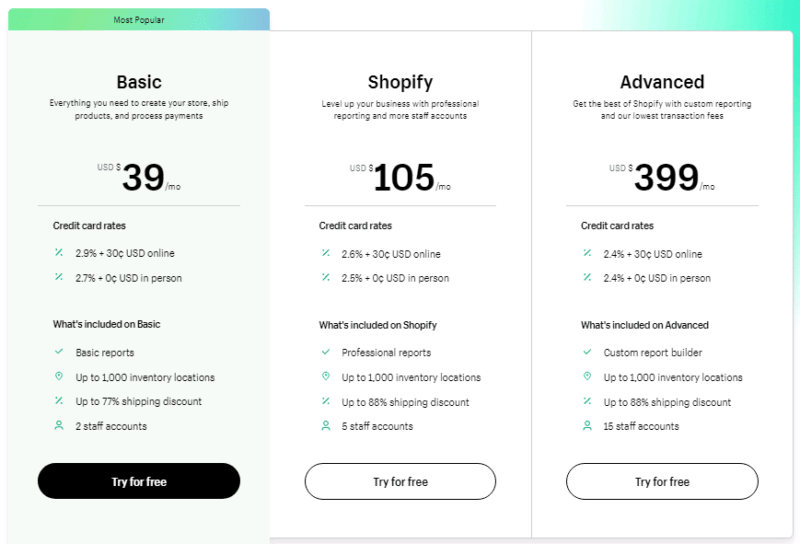My content is reader-supported by awesome people like you. Which means I could earn a commission. Learn more here!
Shopify and Amazon are two of the most popular and widely used eCommerce platforms available today.
Shopify, founded in 2004, is a hosted eCommerce solution that allows businesses to easily create and manage online stores.
Amazon, which started as an online bookstore in 1994, has evolved into the world’s largest online marketplace where third-party sellers can list and sell their products.
Both Shopify and Amazon have their own unique strengths and differences that make them suitable for different types of businesses and selling models.
This comparison aims to provide an overview of the key features, pricing, and overall pros and cons of each platform to help businesses evaluate which solution may be the better fit for their needs.
While Shopify offers more customization and control for running an independent online store, Amazon appeals to those wanting access to an established marketplace with millions of buyers.
By exploring factors like fees, functionality, sales channels, and more, businesses can make an informed decision when choosing between these two eCommerce giants.
Try Shopify Free Or Try Amazon
Shopify Vs Amazon Summary
| Which one wins? | Shopify wins overall but these 2 complement each other and you should consider both depending on what type of eCommerce business model you have. |
| Which one is easier to get started with? | Shopify is going to offer you an easier process in my opinion. |
| Some pros of Amazon | Millions of visitors daily & can handle your inventory |
| Some pros of Shopify | Very powerful eCommerce features & a large community for Shopify which can help with help and question you may have. |
| Ease of use winner | Shopify wins this battle |
Pricing and Fees
Shopify and Amazon take different approaches when it comes to pricing and fees.
Shopify charges a monthly subscription fee starting at $29/month for their basic plan.
There are no transaction fees on the basic Shopify plan.
However, you will need to pay additional fees for advanced features like abandoned cart recovery or payment processing.
Amazon takes a different approach, charging no monthly fee but collecting fees on each sale.
Amazon’s referral fees start at 15% of the product price plus a variable closing fee per item sold.
Fees are higher for categories like electronics. Amazon also charges monthly storage fees based on inventory size.
The main extras both platforms charge for include payment processing fees of around 2-3% and additional fees for marketing services.
Shopify charges for tools like email marketing, Amazon Advertising fees apply for sponsored products.
So Amazon can work out cheaper for very low-volume sellers, while Shopify’s predictable monthly fees appeal to established businesses.
But both platforms offer premium plans with advanced features for additional fees.
The costs scale up as your business expands.
Ease of Use With Amazon And Shopify
When it comes to ease of use, Shopify is generally considered more user-friendly for setting up and managing an online store compared to Amazon.
Shopify uses a simple drag-and-drop interface that allows anyone to quickly build and customize an online store without needing to know how to code.
There are plenty of themes, apps, and integrations available to enhance the store’s functionality and design.
Shopify also provides step-by-step guidance, tutorials, and 24/7 customer support to help merchants throughout the process.
In contrast, selling on Amazon can be more complex for those without eCommerce experience.
Amazon’s Seller Central dashboard is dense with data, options, and settings that may seem overwhelming initially.
Merchants need to understand how to optimize listings, manage inventory across Amazon’s fulfillment centers, navigate promotions and advertising, and analyze metrics to succeed.
While Amazon does offer Seller University resources, sellers often turn to external agencies or coaches for specialized assistance.
Overall, Shopify’s intuitive store builder and abundant educational resources make launching an online business easy for first-timers.
Selling on Amazon has a steeper learning curve but can work for experienced eCommerce sellers who are prepared to handle the platform’s extensive options and logistics.
Store Customization For These eCommerce Giants
Shopify offers much more customization options compared to Amazon when it comes to store design and branding.
With Shopify, you have complete control over the look and feel of your online store.
You can choose from a wide variety of themes and then customize it further with your own colors, fonts, and images to match your brand.
Shopify themes are very flexible and you can modify sections like the header, footer, product pages etc.
There are also lots of apps and integrations to extend functionality.
Amazon stores on the other hand offer minimal customization.
The store layout and design are controlled by Amazon.
You get to choose a template when setting up your Amazon store but after that, there is not much you can customize beyond some colors and text.
Amazon is more rigid and optimized for Amazon’s own goals.
So if you want a store that reflects your unique brand identity, Shopify is the better choice.
Try Shopify Free Or Try Amazon
Product Management
Shopify and Amazon take different approaches to product management.
Shopify offers a centralized dashboard to manage product listings, inventory, and orders.
Merchants have full control over adding, editing, and removing products.
They can create unlimited product variants, track inventory across multiple locations, and enable auto-fulfillment rules to manage order processing.
Shopify also provides advanced reporting on sales, profits, and inventory levels.
Amazon requires sellers to send their inventory to Amazon warehouses for fulfillment by Amazon (FBA).
Amazon manages the storage, packing, and shipping of FBA products.
Sellers can track inventory and make bulk updates but do not have the same level of control as with Shopify.
Amazon sets certain requirements for product listings, like the need for a Universal Product Code (UPC) and high-quality images.
Sellers have less flexibility over product variants and bundling compared to Shopify.
Overall, Amazon’s product management system is more rigid and tailored to its fulfillment processes.
So Shopify offers sellers more customization and transparency for managing product listings and inventory, while Amazon controls more of the fulfillment process through FBA.
Sellers should weigh the trade-offs based on their specific needs.
Payment Options
When it comes to accepting payments, Shopify and Amazon offer some key differences in the options available.
Shopify supports over 100 payment gateways including major processors like Stripe, PayPal, and Square.
Shopify Payments is their own payment processing system which charges lower transaction fees of 2.4% + 30¢ for online transactions and 2.7% for in-person transactions.
Shopify also supports third-party POS systems and hardware like Square and Clover for brick-and-mortar stores.
Amazon Payments used to be their own payment processing system but it has now been retired.
Sellers on Amazon can accept payments through Amazon’s checkout system which supports credit cards, debit cards, gift cards, and Amazon Pay.
Transaction fees range from 3-5% depending on the product category.
Overall, Shopify offers more flexibility with payment options, especially for physical retail locations.
However, Amazon provides a seamless checkout experience for customers already within their ecosystem.
Marketing and SEO
When it comes to marketing tools and SEO optimization, Shopify and Amazon take different approaches.
Shopify includes a variety of built-in marketing features to help merchants promote their stores.
The platform offers an email marketing tool, targeted discount and coupon capabilities, and the ability to run Facebook and Instagram ad campaigns directly from Shopify.
Merchants can also use the Shopify blog to create SEO-optimized content to draw in organic traffic.
Shopify also provides recommendations on improving site SEO through its dashboard.
However, merchants need to have their own marketing strategy and invest in driving traffic to their independent stores.
Amazon takes care of marketing for sellers on its marketplace.
Because Amazon attracts millions of built-in customers, sellers don’t have to focus as much on marketing efforts or SEO optimization.
Amazon’s A9 algorithm optimizes product listings for search relevancy.
Sellers only need to provide quality content for their product listings.
However, merchants have little control over how their brand is marketed and don’t own customer relationships.
Overall, Shopify gives merchants more marketing and SEO control, while Amazon handles marketing for sellers using its built-in traffic and algorithms.
Shopify is better for branding and driving direct traffic, while Amazon helps sellers tap into its existing customer base.
Sales Channels
Shopify and Amazon offer merchants multiple sales channels to sell their products, allowing them to diversify and expand their reach.
Shopify merchants can sell through:
- Their own online Shopify store
- Online marketplaces like Amazon, eBay, and Etsy by integrating these channels into their Shopify store
- Brick-and-mortar retail locations using Shopify POS
- Pop-up shops and markets
- Mobile commerce through POS and apps
- Social media channels like Instagram and Facebook using Shopify integrations
Amazon merchants can sell through:
- Amazon’s marketplace
- Amazon stores like Amazon Handmade and Amazon Launchpad
- Mobile apps like Amazon Shopping
- Alexa voice shopping
- Social media shoppable posts
- Retail locations through Amazon Counter pick-up points
A key difference is that Shopify gives merchants their own branded storefront and full control over their customer relationships.
With Amazon, merchants rely on Amazon’s marketplace and customers.
Amazon also charges fees for optional add-ons like advertising and fulfillment.
Shopify lets merchants choose their preferred sales channels and integrate them through a single dashboard.
Overall, both platforms offer robust omnichannel sales capabilities, but Shopify provides more flexibility for merchants to sell through their preferred channels. Amazon locks sellers into their ecosystem.
Try Shopify Free Or Try Amazon
Shopify vs Amazon For Support and Community
Shopify offers multiple support options for merchants including 24/7 phone and chat support, an extensive help center with articles, tutorials, and guides, as well as an active community forum for asking questions and getting help from other Shopify merchants.
They also offer Shopify Experts that you can hire for specialized help with building, marketing or managing your store.
Amazon offers very limited support options for sellers.
Phone and chat support is only available during business hours on weekdays.
The seller forums offer some community support but response times can be slow.
Amazon does have a ‘Seller University’ with some tutorials and guides.
However, overall their support resources are lacking compared to Shopify.
Sellers are largely left to figure things out on their own.
Shopify’s superior customer service, wide range of support options, and engaged user community give it a clear advantage over Amazon when it comes to supporting merchants.
The hands-on help available via Shopify allows new eCommerce entrepreneurs to get their businesses up and running more smoothly.
FAQ On Shopify Vs Amazon
What is the difference between Shopify and Amazon?
Shopify and Amazon are two major players in eCommerce, but they operate very differently.
Shopify is an eCommerce platform that allows merchants to build and customize their own online stores. Shopify stores are hosted on Shopify’s servers, but merchants have full control over the design, content, and functionality of their stores.
In contrast, Amazon is primarily an online marketplace where third-party merchants can sell their products. Amazon provides the platform for third-party sellers, but merchants must play by Amazon’s rules in terms of pricing, fulfillment, and more.
Some key differences between Shopify and Amazon:
-
Shopify offers much more customization and control over the look and feel of your online store. Amazon restricts you to their templates and rules.
-
Shopify charges monthly subscription fees based on your plan. Amazon has no monthly fees but takes a commission on each sale.
-
Shopify provides support, tools, and apps to help optimize your independent store. Amazon offers Fulfillment by Amazon and leverages their massive site traffic.
-
Shopify is just for your products. Amazon has millions of other sellers competing for buyer attention.
So Shopify is best for brands wanting a customized, independent store under their own domain. Amazon is better for tapping into their massive built-in audience, but less customization. Many merchants use both platforms to maximize their reach.
Is Shopify better than Amazon?
Shopify and Amazon are both powerful ecommerce platforms, but which one is right for your business depends on your specific needs and goals. Here’s a comparison of some of the key differences between Shopify and Amazon:
-
Branding and customization: Shopify offers much more customization, branding capabilities, and control over the look and feel of your online store. With Shopify, you can fully customize your store’s design, product pages, checkout process and more. Amazon limits branding and forces sellers to conform to their marketplace rules and interface.
-
Fees: Shopify has a monthly subscription fee starting at $29/month but lower transaction fees of 2.9% + 30¢ per transaction. Amazon has no monthly fees but higher selling fees of 8-15% of the product price. With Amazon, you also pay storage and advertising fees.
-
Integrations and ecosystem: Shopify seamlessly integrates with many platforms and apps, allowing extensive customization. Amazon’s marketplace ecosystem is more closed with limited integrations.
-
Established brands vs marketplace: Shopify is better suited for established brands looking to sell direct-to-consumer. Amazon’s marketplace has fantastic built-in traffic but less branding control.
Overall, Shopify usually works better than Amazon for branded manufacturers, wholesalers and established retailers looking to build their own branded storefront online. The expanded branding and customization capabilities make Shopify better for direct-to-consumer ecommerce for many businesses.
Amazon’s marketplace model has advantages like built-in traffic and discoverability. But the limited branding and control make Amazon less ideal for branded manufacturers wanting a more customized storefront. Amazon tends to work better for smaller 3rd party sellers looking to tap into Amazon’s built-in audience.
So Shopify offers more branding and customization while Amazon provides discoverability and built-in audience access. Consider your specific business goals and needs to determine if Shopify or Amazon (or both) are a better fit for your ecommerce plans.
Can you use both Shopify and Amazon?
Yes, many sellers use both Shopify for their storefront and Amazon marketplace for added sales. Shopify offers channel integrations to list products on Amazon easily. This allows you to manage your products and inventory in one place on Shopify, while syncing your listings to Amazon as well.
The main benefit of using both platforms is to increase sales channels and reach more customers. Shopify gives you a customizable online store with branded shopping experience. Amazon provides exposure to their massive buyer traffic. So using both platforms extends your ecommerce business.
However, managing inventory and order fulfillment takes extra work when using both Shopify and Amazon together. You’ll need to closely track and sync inventory levels to avoid overselling. Orders placed on Amazon must be fulfilled following their policies, even when managed via Shopify.
Another consideration is Amazon fees still apply for sales made via Amazon through Shopify integrations. Referral fees, FBA fees, and other selling costs on Amazon continue to cut into margins. So the extra sales on Amazon come with additional platform fees paid to Amazon.
Overall, many merchants find the combination of Shopify and Amazon to be beneficial for growing their business. But selling on both does require more work and costs compared to using just one platform. The tradeoff for increased sales and reach is higher complexity in operations.
Is Shopify cheaper than Amazon?
When it comes to costs, both Shopify and Amazon offer competitive pricing models but ultimately it depends on your specific business needs. Here’s an overview of the key differences in fees between the two platforms:
-
Shopify has a monthly subscription fee starting at $29/month for their basic Shopify plan. However, they have no referral fees on product sales.
-
Amazon has no monthly fees but charges referral fees on each product sale. Referral fees range from 8-15% on average.
-
For low volume sellers just starting out, Amazon’s fee structure can work out cheaper since you avoid monthly fees. However, as your sales volume increases, Shopify becomes more cost effective since you avoid paying referral fees on each transaction.
-
For established brands doing medium to high sales volume, Shopify is generally the cheaper option long-term. The monthly fee is predictable and you avoid variable referral fees.
-
Both platforms also have additional costs for features like payment processing. Shopify Payments charge 2.9% + 30¢ per transaction for online payments. Amazon Pay charges 2.9% + 30¢ per transaction similar to Shopify.
Overall, Shopify can provide better value for growing brands selling more than $1000-2000 per month. But Amazon’s no monthly fee and low referral rates work better for very low volume sellers. It’s important to factor in all costs like transaction fees when comparing the two.
Can I switch from Amazon to Shopify?
Yes, many sellers migrate from Amazon to Shopify for more control and branding. Moving your business from Amazon to Shopify is possible, but requires some effort to recreate your listings, set up new fulfillment methods, and migrate reviews.
The benefit of Shopify is much more control over your branding, customization, and ability to own the customer relationship. Shopify offers support to help sellers migrate from Amazon and even integrates with Amazon through their channel integration app. This allows you to continue selling on Amazon while also operating your Shopify store.
To switch from Amazon, you will need to:
- Set up a Shopify store and optimize it for your products.
- Recreate your product listings and inventory in Shopify.
- Find a new fulfillment method if using Fulfillment by Amazon. Shopify offers integrations with many fulfillment centers.
- Redirect website traffic to your new Shopify store.
- Offer discounts or incentives for customers to create a new account on Shopify.
- Use marketing and email campaigns to inform customers of your new Shopify store.
For many sellers, keeping Amazon as a sales channel for added reach and volume can be a smart approach. Use Amazon to tap into their huge buyer base, while focusing more branding and customer ownership efforts on your Shopify store. You can also selectively promote certain products on each platform. This hybrid model gives you the control of Shopify with the scale and reach of Amazon.
With some upfront work, most ecommerce businesses can successfully migrate from Amazon to Shopify and greatly expand their branding and customization capabilities. Shopify provides support and apps to help the transition be as smooth as possible.
Is Shopify or Amazon easier to use?
Shopify and Amazon both provide powerful eCommerce platforms, but differ significantly in their ease of use and setup.
Shopify offers a simpler, more intuitive interface that makes it easy for merchants to quickly build and customize an online store. The backend dashboard is clean and streamlined, allowing you to manage products, orders and settings without having to dig through complex menus. Shopify also provides guided setup flows, tutorials and 24/7 support to help merchants get started.
However, Shopify requires more work when it comes to driving traffic and marketing your store. Merchants need to build their own audience through SEO, social media, email marketing and other channels. There is no built-in marketplace of buyers like Amazon’s site.
Amazon has a much steeper learning curve for sellers. The interface can be dense and overwhelming to navigate at first. Merchants need to understand all of Amazon’s policies, programs and fees to successfully sell while avoiding violations. Managing inventory and orders across Amazon’s fulfillment network can also be complex.
But Amazon provides immediate access to millions of active buyers on its marketplace. Merchants can tap into Amazon’s logistics programs like Fulfillment by Amazon (FBA) for storage, shipping and returns. Amazon also handles most of the marketing, payments, customer service and infrastructure for sellers.
So Shopify offers more simplicity and customization upfront, while Amazon provides built-in traffic and logistics but requires more time investment to master selling on the platform. Shopify caters better to small businesses wanting an branded, customizable storefront, while Amazon appeals to larger sellers wanting to tap into established ecommerce infrastructure.
What sells better on Shopify vs Amazon?
Amazon and Shopify are suited for selling different types of products. Here’s a quick overview of what typically sells better on each platform:
-
Amazon is often better for inexpensive, commodity-type products where there is a lot of competition. Amazon’s huge customer base and popularity for price comparisons gives high volume sellers an advantage. categories like consumer electronics, media, and books sell very well on Amazon.
-
Shopify tends to be better for branded, unique, and niche products. Shopify stores allow sellers to tell a story and build a branded experience around their products. Customers may be willing to pay more for something special or unique. Items that need custom branding, excellent photography, or detailed storytelling often sell better on Shopify.
-
Handmade and artisanal goods also tend to do better on Shopify where sellers can showcase their brand and story. Commodity products with lots of competition do not thrive as well on Shopify.
So in summary, Amazon’s platform favors high volume commodity products while Shopify works better for branded, artisanal, and specialty niche products. Consider your product type, audience, and brand story when choosing the best sales platform.
Can I use Fulfillment by Amazon with Shopify?
Yes, Amazon’s Fulfillment by Amazon (FBA) service integrates with Shopify, allowing Shopify merchants to easily fulfill orders using Amazon’s fulfillment network and capabilities. This makes the fulfillment process straightforward for Shopify sellers.
When using FBA with Shopify, Shopify handles the front-end ecommerce store, product listings, and order management. When an order is placed, Shopify sends it to Amazon, which takes over warehousing, picking, packing, and shipping the order on behalf of the Shopify seller.
One of the key advantages of this integration is that Shopify merchants can tap into Amazon’s massive fulfillment infrastructure and fast shipping speeds. For example, with FBA, Shopify sellers get access to fulfillment centers close to many customers for quick 1-2 day delivery.
However, when using FBA with Shopify, merchants need to carefully manage inventory across both platforms. Product quantities must be kept in sync on Amazon and Shopify to avoid overselling an item. In addition, Amazon’s FBA fees still apply for any products stored and shipped by Amazon. So FBA costs need to be factored in when evaluating profitability.
Overall, FBA integration makes fulfillment seamless for Shopify merchants who want Amazon’s warehousing and logistics capabilities. But inventory and fees require diligent oversight when using both platforms together.
Which platform has better payment processing fees?
When it comes to payment processing fees, Shopify and Amazon offer some key differences:
-
Shopify offers competitive credit card processing with rates starting at 2.4% + 30¢ per transaction. This makes their processing fees quite affordable for most ecommerce businesses.
-
Amazon’s payment processing fees vary more by product category, averaging around 3% for electronics and other popular segments. Their fees tend to be a bit higher overall compared to Shopify’s base rates.
-
Both platforms offer their own digital wallet solutions like Shopify Payments and Amazon Pay to potentially reduce processing costs. These can streamline checkout conversion if customers already have accounts.
-
A major advantage of Shopify is integration with dozens of third-party payment gateways like Stripe, PayPal, and Authorize.Net. This provides more options for custom rates and features based on your business needs.
-
With Amazon, you are generally limited to their Seller Central payment processing. Though they do offer a Pay with Amazon program as an alternative.
Overall, Shopify provides more flexibility and transparency with competitive payment processing fees starting at 2.4%. Amazon’s varying fees average slightly higher around 3% for many product categories. So Shopify generally has better rates, but Amazon’s built-in customer base can offset higher costs.
Which platform is better for SEO?
When it comes to SEO, Shopify gives sellers more control compared to Amazon. This allows Shopify stores to optimize for search engines like Google more effectively.
On Shopify, sellers have full control over important on-page SEO elements like URLs, meta descriptions, title tags, alt text, and more. Shopify also provides built-in SEO tools to help optimize pages and content for keywords.
In contrast, Amazon controls product listings and limits the SEO optimization sellers can do. Amazon’s goal is to optimize product pages for their own internal search, not Google. Sellers don’t get access to edit page URLs, meta data, or on-page content.
With Shopify, sellers can create custom URLs, meta descriptions, title tags optimized for search engines. All the content is fully customizable to target relevant keywords and phrases.
On Amazon, the product page URLs and key content are standardized and optimized for Amazon’s internal search goals. Sellers have little control over optimizing Amazon listings for Google and external organic search.
So Shopify provides more SEO flexibility and control compared to Amazon. With Shopify, sellers aren’t limited by Amazon’s rigid structure and can customize pages for optimal organic search results.
Try Shopify Free Or Try Amazon
Conclusion On Shopify vs Amazon For eCommerce
When deciding between Shopify and Amazon as an eCommerce platform, it really comes down to your business needs and goals.
Shopify is likely the better choice if you want more customization and control over your online store.
With Shopify, you can fully brand your store, design your own website layout, and integrate with many different tools and apps.
Shopify also has powerful built-in marketing features to help drive sales.
The main downside is the additional fees compared to Amazon.
Amazon makes more sense if you want to get up and running quickly at low cost.
By selling through Amazon, you instantly gain access to their massive buyer audience.
However, you have less flexibility over the look and feel of your listings.
Amazon also takes a cut of each sale made through their marketplace.
Ultimately, Shopify is ideal for established merchants focused on growing their own independent brand.
Amazon provides an easy entry point for those still testing or validating a product concept.
As your business grows, you may consider expanding into both channels to access the widest possible customer base.
No matter which platform you choose, focus on providing a seamless buying experience, top-notch customer service, and consistent value.
The foundation of eCommerce success lies in delighting customers, not the tools and technologies used behind the scenes.
By staying customer-centric, you can build a thriving online business on Shopify, Amazon, or both.









Leave a Reply